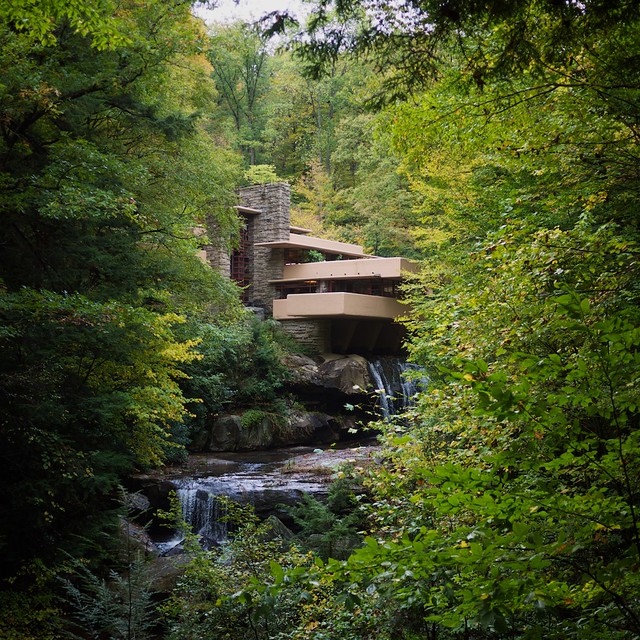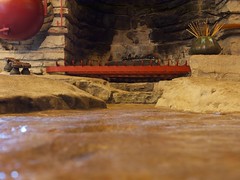A Pilgrimage to Fallingwater

When I lived in the U.S. a few years back, one of my very highest priorities was to make a trip to Fallingwater. Informing folks of this ambition invariably elicited one of two reactions: a knowing smile and a slow nod; or knitted eyebrows and a ‘what’s that?’. This is for the second group.
Fallingwater is a house, the former holiday home of the Kaufmann family. It is also one of the most remarkable and important houses ever built. It was designed by Frank Lloyd Wright in 1935, at the height of the Great Depression.
At the time, Wright was regarded as a has-been. Though many of his ideas had earlier been influential in the development of Modern architecture, he steadfastly refused to embrace the International Style that had become the signature of the movement. His existing works stood mostly as monuments to a horse-and-buggy era that had long since passed. A combined axe-murder/arson spree had claimed the life of his mistress as well as most of his beloved Taliesin ranch in 1914. He had built but one commission since the Wall Street Crash five years before. At 67, all of his best-known work1 [1 Such as the Solomon R. Guggenheim Museum (1956–1959) in New York City.] remained ahead of him. It was into this world that Fallingwater sprang forth.

The first thing you notice as you approach the house is that the breathless descriptions of it looking just like a waterfall, so overblown next to the iconic images of the place, are actually completely accurate. At a certain point on the driveway, the combination of the main house and the covered walkway to the guesthouse2 [2 Although the guesthouse was built somewhat later, it was to Wright’s design and had been part of his original concept.] above really does have the appearance of a waterfall cascading down the hill. The concrete roofs have rounded edges and no guttering, so rainy weather sees a curtain of water steadily pouring off them.
The effect continues inside, where the rough stone floors of the lower level are waxed to give the impression of a stream flowing through the house. Every aspect of the complex feels intimately connected to the nature surrounding it—from the balconies, cantilevered precariously over the waterfall below, to the deepest recesses of the rooms, designed to evoke caves with their wide, glazed mouths accentuated by a preceding drop in the ceiling level.

Wright had adopted the language of Modernism—glass, steel and concrete3 [3 Though the natural elements of stone and wood remain prominent too.]—and yet fashioned it into as profound a rejection of the Modernist sensibility as could be summoned in a single building. Architects of the International Style built houses entirely out of boxes; Wright pushed the limits of the available materials to explode boxes. Philip Johnson refused to allow pillows to be kept on the bed of his Glass House (1949) in Connecticut, lest they spoil its clean lines; Wright allowed part of the rock on which the house was built to protrude through the floor.4 [4 The original plan called for it to be cut it off, but he acceded to a request from Edgar Kaufmann (Sr.) to preserve what had been the family’s favourite picnic spot.] Le Corbusier famously wrote that ‘a house is a machine for living in’;5 [5 Le Corbusier, Vers une architecture (G. Crès, 1923).] Wright built atop a running waterfall a home to satisfy the most primal psychological needs of the human animal.
This was no half-hearted attempt by an aging has-been to pay lip service to the latest trends, it was a full-throated attack on the philosophical foundations of the Modernist movement. Wright had met the challenge of Modernism head-on and transcended it. I like to think of Fallingwater as the first post-modern building.
For me, that is why Fallingwater remains such an inspiring place. As a software engineer, I am acutely aware that my profession spent decades in thrall to a Modernist worldview6 [6 Hugh Robinson, Pat Hall, Fiona Hovenden and Janet Rachel, ‘Postmodern Software Development’, The Computer Journal Vol. 41, no. 6 (1998), pp. 363–375.]—in particular the philosophy of logical positivism (which, oddly, had already been rejected by philosophers as intellectually bankrupt before a software industry had even existed). Even today, the Modernist approach to software engineering has been displaced—to the extent that it has been displaced at all—only by a vacuum. The most widely-practiced software engineering subcultures are ahistorical and devoid of any organising principle.
Here is a (quite literally) concrete example that it need not be thus.
